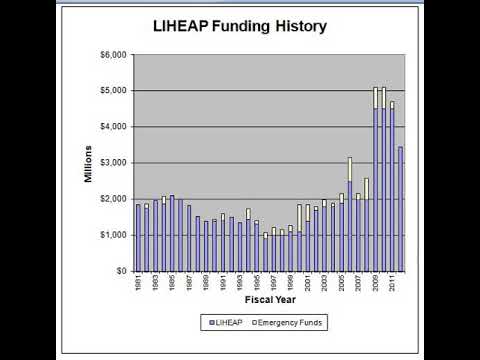The Low Earnings Home Power Help Program
( LIHEAP) is a United States federal social solutions program initially developed in 1981
and moneyed each year via Legislative appropriations. The mission of LIHEAP is to assist reduced revenue
houses, particularly those with the most affordable incomes that pay a high percentage of house
revenue for home power, primarily in meeting their immediate home power needs. The program, component of the United States Division
of Health and Human Provider (HHS), is funded by gives appropriated from the federal government. == Funding distribution ==.
Funding is dispersed per of the fifty states, united state regions and tribal governments.
with the USA Division of Health and Person Services (HHS). Management of the program is left approximately.
state, tribal or territorial governments. Congress likewise provides the Head of state of the.
USA with restricted contingency funds each year, which are scheduled for emergency situation.
LIHEAP uses single financial help. Candidates must have an earnings less than 150%.
The Reduced Revenue Home Power. Aid Program( LIHEAP )provides financing help to low-income houses, targeting. those that are absolutely at risk: the impaired, senior, and households with preschool-age kids. Funding is dispersed to states or various other. governmental entities, that administer the program and originates from four sources consisting of:.
Block gives, the Residential Power Assistance Difficulty Program, Backup Finances, and. Leveraging Incentive Programs. Allowances are based on neighborhood climate, financial,. and demographic formulas.Additional funds might be readily available in emergency situation. scenarios or as suit funds when contributions are offered by city governments, personal. services, or charitable organizations. Final distribution of funds is performed through. the program beneficiaries, which are
able to make their programs to meet customer needs while. adhering to the objectives and policies of LIHEAP. In a lot of states, the program is run on a. come-first served basis. This commonly causes a thrill to apply. and receive help, due to the fact that once the funding swimming pool
is empty most power aid workplaces. close their doors.
In some states, the legislature or governor. may make a politically prominent
gesture of extending eligibility to extra individuals.
This program is specifically carried out.
by the state and different Organizations of Federal governments( AOG). The Hill land AOG supplies H.E.A.T. aid to persons in Utah, Wasatch, and. Summit Counties. Numerous state LIHEAP firms additionally offer weatherization. support, in which professionals are sent to houses to make physical modifications to help. preserve warm or mount more fuel-efficient furnaces. Periodically, approval of the weatherization.
process is obligatory with approval for LIHEAP help. Some states have actually attempted to enact Portion.
== History==. LIHEAP background started in 1980 when congress produced the Low Income Energy Assistance Program.== Administration==.
LIHEAP is carried out by the Department of Health And Wellness and Human Services.Several government departments give oversight. and direction to the program. These consist of the Management for Kid. and Family members Providers
, the Workplace of Community Providers, and the Department of Power Aid.
The National Facility for Appropriate Innovation.
The federal government does not provide LIHEAP. Rather, the federal government provides funds.
LIHEAP grantees have adaptability to design. their programs, within really broad government guidelines, to satisfy the needs of their residents. Each state might have varying departments or.
divisions to disseminate funds. Shown over is the program flow from the federal.
In Utah, LIHEAP funding is handled with. The Mountainland AOG provides direct oversight. MAG receives virtually$ 2.5 Million annually.
State of Illinois has introduced in 2014 that.= =Federal financing== LIHEAP is funded by annual appropriations. The financing for the fiscal year
2017 is$ 3.09.
federal governments with the USA Division of Health And Wellness and Human Services (HHS). Management of the program is left as much as. state, territorial or tribal federal governments. Congress also provides the Head of state of the. United States with minimal contingency funds yearly, which are reserved for emergency situation. circumstances and launched at the President ' s discretion. State legislatures frequently offer extra. appropriations yearly to supplement government LIHEAP funds.=== Funding resources== =. The quantity of funding offered for real aid originates from 4 major resources including:. Block gives, the Residential Energy Support Obstacle Program, Contingency Funds, and. Leveraging Reward Programs. The following is a summary of
how these resources. tie right into LIHEAP.=== Block gives ===. Block gives account for most of dollars dispersed for the LIHEAP program. To be granted a block give, states, areas,. Indian people, and tribal organizations that desire to help low-income homes in meeting. the prices of home energy, may look for a LIHEAP block give.

=== Residential Power
Assistance Difficulty. Program (REACH)= == The Residential Power Help Challenge. Program( REACH) “offers grants that money presentation tasks to examine various strategies. to aid low-income family members lower their energy use and come to be a lot more
self-dependent in meeting. their home power needs.” Neighborhood community-based companies that implement.
As of 2001, 54 REACH grants had been moneyed.
=== Contingency funding===. Backup funds are funds that are released to help with home power needs due to emergency. Usually, these funds are released in response.
=== Leveraging Reward Program===. The Leveraging Incentive Program is made to compensate those grantees that have gotten. Furthermore, beneficiaries are encouraged to incorporate.
Participation in this program is optional,. If non-federal bucks are reported, the beneficiary can get extra LIHEAP funds.
qualified homes, would certainly be reported as a leveraged or non-federal resource and be.
== How LIHEAP and WAP work with each other==. Reduced Income Home Power Support Programs (LIHEAP) and Weatherization Help Programs. LIHEAP and WAP literature is likewise checked out.
Finally, a section detailing proficiency in low-income. consumers is included.
=== Overview= ==. The objective of the Reduced Earnings Power Help Program (LIEAP)( additionally referred to as Low Income. Home Power Help Program (LIHEAP) ), developed in 1981, is to help reduced income houses,. particularly those with the lowest earnings that pay a high proportion of household income. for home energy, largely in satisfying their immediate home energy requirements. The program, part of the United States Division. of Health And Wellness and Human Solutions( DHHS), is funded by grants appropriated from the federal government.LIHEAP pays partial winter
power expenses for. qualified individuals and family members. Payments are normally made straight to neighborhood.
energy companies or suppliers. To be eligible, a specific ' s income degree.
have to not be even more than 150% of the government poverty line. The payment amount is figured according to.
the size and sort of your home, along with type of gas. A news release from the Division of Wellness. and Human Providers on June 5, 2013, suggests that$ 187.4 million was launched to states. to help low-income property owners and occupants with climbing energy costs. This funding supplements$ 3.065 billion
in. grants provided previously in the year through The Low-Income Home Power Support. Program (LIHEAP). The funding serves to help families pay their.
home heating and electricity, as well as make weather-related enhancements to their homes. This helps to stop these family members from. having solution interruptions. George Shelton, HHS acting assistant secretary.
for the Management for Children and Households, mentioned that heats equate right into.
high power bills for households that are already having a hard time to make ends fulfill. === Summary of the Weatherization Support.
Program (WAP )=== The United States Weatherization Aid. Program( WAP) was created in 1976 to
help low-income family members lower energy intake. and costs.
WAP is controlled by various government policies. created to aid handle and account for the resources offered by the Division of Energy.( DOE). WAP funding is originated from yearly appropriations. from Congress.
Each year, the Senate and Home Inside Appropriations. committees decide how much financing to allocate to the Program. WAP specialists execute power audits on a. home to assist locate effectiveness issues. When an audit is full, the program can. assistance by shielding wall surfaces and home windows, replacing damaged glass, and testing, fixing, and/or. changing combustion devices. Like the LIHEAP, a specific ' s income level. have to be at or listed below 150% of the government poverty line to be eligible for the WAP.Many state WAPs and LIHEAPs function with each other.
to offer the very best energy solutions for low-income homes.
=== WAP===. LIHEAP and WAP are the foundations of any type of public energy aid program.
At the Montana energy assistance workplaces,. When they are registered in the LIHEAP, customers are automatically enrolled in the WAP. This organization is suitable being that the.
LIHEAP and WAP are usually situated in the very same office. In Butte, Montana, the Energy Support office. and Weatherization divisions( which become part of the Human being Resources Council, District. XII) supervise of LIHEAP and WAP. Each department provides numerous various other programs. that aid low-income people and families with home heating and power issues. When a client transforms and finishes in an application.
for LIHEAP, they are instantly enrolled in WAP. After the application is refined, it normally. takes one to two weeks to obtain economic assistance for their home heating and power expenses. Throughout this time around, the applicant is called. by the WAP division. Prior to a client ' s home can be weatherized,. an auditor comes to the home to finish a power audit. The auditor is educated to identify the many.
inexpensive weatherization procedures for the home.Weatherization steps might include caulking,.
weather-stripping, insulation, air vent dampers, replacement of broken glass, repair or substitute. of primary doors, and heater tune-ups.
When a home is arranged for weatherization. Working with each other to offer energy. The program literary works consists of even more than.
Over the previous years, funding for LIHEAP has.
The President ' s budget proposal in 2012 significantly. The two major factors why the spending plan has actually been. Performance Measures and Reporting.
ANNUAL STEP FY TARGET RESULT 1A. BOOST'THE RECIPIENCY TARGETING INDEX SCORE.
OF LIHEAP HOUSEHOLDS HAVING AT LEAST ONE MEMBER 60 YEARS OR OLDER. 2004 82 78 2003 Standard 79.
LIHEAP efficacy is kept track of on a normal basis via its recipiency targeting index.
This index evaluates the level to which. support eligible homes are obtaining LIHEAP assistance.
An index score above 100 indicates
that LIHEAP. The table at right reflects the target scores. Each December, state LIHEAP beneficiaries are required.
2003 LIHEAP and relevant data are obtained from LIHEAP grantee records and surveys, nationwide. Much of the data are released in the division ' s. LIHEAP Home Energy
Notebook and the LIHEAP Report to Congress. While the program managers utilize the above actions and
reports to understand comprehend exactly how.
The 2008 spike in funding was needed
to addressResolve 2008 degrees might not be enough to deal with the ongoing climbing of heating prices and its. Not only are fuel prices proceeding to boost, program receivers are on the rise.This might be illustrated in the complying with chart.
revealing the boost in homes served by the program in relationship to the amount of. LIHEAP funds assigned'to
the State of Utah. Some data of note for the State of Utah. include: SEALworks recorded that 1,619 homes were. closed off before coming in for HEAT assistance warm program helped protect against 10,243 families,. that had actually shut off notices, from being turned off.
Virtually$ 375,769 in normal warm Dilemma support aided 1,373 family members in 2011.
The program offered 18,592 families with young youngsters in 2011. The program helped 10,875 elderly houses to obtain HEAT support in 2011. The program aided 17,947 individuals that have specials needs in 2011Coordination with Outdoors.
Questar ' s Power Support Fund and REACH program, Catholic Neighborhood Services, American. Red Cross, and Murray City Relief Program. H.E.A.T. funding applicants might be referred to these. or various other exclusive help
groups if there are not sufficient LIHEAP funds.
=== Financing sources== =.=== Contingency financing===.=== Leveraging Reward Program===.=== Review= ==.=== WAP===.

